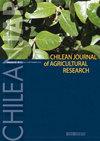Effect of nitrogen rate and water replacement level on leaf biomass production and leaf nitrogen concentration of ten pot-grown blueberry cultivars
IF 1.7
4区 农林科学
Q2 Agricultural and Biological Sciences
引用次数: 1
Abstract
Soilless blueberry ( Vaccinium corymbosum L.) production is an alternative system that is increasing worldwide in surface area. There is little scientific information available as yet on the agronomic management of this cultivation system. The objective of the present study was to evaluate four N rates (0%, 100%, 200%, and 300% of the reference rate) and three water replacement level (70%, 100%, 130%) on leaf biomass production and leaf N concentration previous to winter fall (May and August 2021) in 10 pot-grown blueberry cultivars (Blue Ribbon, Duke, Camelia, Cargo, Last Call, Legacy, Ochlockonee, Suzie Blue, Ventura, and Victoria). An experiment was conducted in south-central Chile (36°55’ S) with first-year plants. During the first growing season, results showed interactions between cultivars, N rates, and water replacement levels; there was a synergistic effect between N rates and water replacement levels on leaf biomass production in ‘Duke’, ‘Camelia’, ‘Ochlockonee’ and ‘Suzie Blue’. Overall, the highest leaf biomass production in most cultivars was obtained with an N rate ranging from 33.2 to 53.1 g plant -1 season -1 (100% and 200% N rates, respectively) and 100% and 130% water replacement levels. Water consumption during the season fluctuated between 93.79 a 136.23 L season -1 . The highest leaf N concentration in most of the blueberry cultivars was obtained with N rates ranging from 33.2 to 53.1 g plant -1 season -1 and 70% and 100% water replacement levels. Therefore, agronomic management recommendations for N fertilization and water replacement levels in blueberries produced with this growing system cannot be generalized. One-year-old blueberry plants were placed in 35 L pots filled with a 2:2:1 (v/v) mixture consisting of coconut fiber, peat, and perlite with a density of 20 000 plants ha -1 . The assay included 480 plants and 1 row for each cultivar. Ten blueberry cultivars were evaluated: ‘Blue Ribbon’, ‘Duke’, ‘Camelia’, ‘Cargo’, ‘Last Call’, ‘Legacy’, ‘Ochlockonee’, ‘Suzie Blue’, ‘Ventura’, and ‘Victoria’. Plants were fertilized twice a week with macro- and micronutrient solutions (Table 2) supplemented with one of four different ammonium sulfate concentrations per treatment. Irrigation was conducted with a drip system from October to April. Ten irrigation lines were placed along the rows of plants to independently irrigate each variety. The treatments were applied at different flow rates with two emitters per plant (Supertif PCND, Rivulis, Kibbutz Gvat, Jezreel Valley, Israel): two emitters at 1.1 L h -1 (70%), one emitter at 1.1 and one at 2.2 L h -1 (100%), and two emitters at 2.2 L h -1 (130%). Plants were irrigated daily at a rate of 2 to 3 min every hour (irrigation events) until substrate saturation (onset of leaching) was reached using an irrigation controller (Pro-C support, Hunter, San Marcos, California, USA). The number of irrigation events per day and the duration of each event were adjusted once a week with a water balance to determine a 100% water replacement level. The water balance was calculated for each variety with four replicates of plants fertilized with 100% N, assuming that the 24 h mean weight loss of the container would be equal to the daily transpiration rate of the plant. Pots and pot plates containing the leachate were removed and weighed with an electronic balance at an accuracy of 2 to 5 g (0.03 to 0.07 mm) on two consecutive days at the same time. Pot changes were used to calculate the total water volumes to control the soil moisture content in the pots according to the following施氮量和水分替代水平对10个盆栽蓝莓品种叶片生物量和氮浓度的影响
无土蓝莓(Vaccinium corymbolsum L.)生产是一种替代系统,其表面积在全球范围内不断增加。迄今为止,关于这种栽培系统的农艺管理,几乎没有可用的科学信息。本研究的目的是评估10个盆栽蓝莓品种在冬秋(2021年5月和8月)前的四种施氮率(参考施氮率的0%、100%、200%和300%)和三种水分替代水平(70%、100%、130%)对叶片生物量产量和叶片氮浓度的影响(Blue Ribbon、Duke、Camelia、Cargo、Last Call、Legacy、Ochlockonee、Suzie Blue、Ventura和Victoria)。在智利中南部(36°55'S)用一年生植物进行了一项实验。在第一个生长季节,结果显示了品种、氮含量和水分替代水平之间的相互作用;“Duke”、“Camellia”、“Ochlockonee”和“Suzie Blue”的氮含量和水分替代水平对叶片生物量产生协同效应。总的来说,大多数品种的叶片生物量产量最高,施氮量为33.2至53.1g植物-1季-1(分别为100%和200%的施氮量),水分替代水平为100%和130%。该季节的用水量在93.79和136.23升季节-1之间波动。大多数蓝莓品种的叶片氮浓度最高,氮含量在33.2至53.1g植物-1季-1和70%和100%的水分替代水平之间。因此,用这种生长系统生产的蓝莓的氮肥和水分替代水平的农艺管理建议不能笼统化。一年生的蓝莓植物被放置在35L的花盆中,花盆中填充了由椰子纤维、泥炭和珍珠岩组成的2:2:1(v/v)混合物,密度为20000株ha-1。该测定包括480株植物,每个品种1行。对10个蓝莓品种进行了评估:“蓝丝带”、“杜克”、“卡米利亚”、“货物”、“最后的呼唤”、“遗产”、“Ochlockonee”、“苏西蓝”、“文图拉”和“维多利亚”。植物每周施肥两次,每次处理补充四种不同硫酸铵浓度中的一种的宏营养素和微量营养素溶液(表2)。10月至4月采用滴灌系统进行灌溉。沿着一排排植物放置了十条灌溉线,以独立灌溉每个品种。处理以不同的流速进行,每株植物有两个发射器(Supertif PCND,Rivulis,Kibbutz Gvat,Jezreel Valley,Israel):两个发射器在1.1L h-1(70%),一个发射器在1.1和2.2L h-1下(100%),两个发射器2.2L h-1(130%)。使用灌溉控制器(Pro-C support,Hunter,San Marcos,California,USA)每天以每小时2至3分钟的速率灌溉植物(灌溉事件),直到达到基质饱和(浸出开始)。每天灌溉事件的数量和每次事件的持续时间每周用水量平衡调整一次,以确定100%的水替代水平。假设容器24小时的平均重量损失等于植物的日蒸腾速率,计算每个品种的水分平衡,其中四个重复的植物都用100%N施肥。同时连续两天取出装有渗滤液的罐子和锅板,并用电子天平以2至5g(0.03至0.07mm)的精度称重。花盆变化用于计算总水量,以根据以下内容控制花盆中的土壤水分含量
本文章由计算机程序翻译,如有差异,请以英文原文为准。
求助全文
约1分钟内获得全文
求助全文
来源期刊
CiteScore
3.00
自引率
11.80%
发文量
60
审稿时长
6 months
期刊介绍:
ChileanJAR publishes original Research Articles, Scientific Notes and Reviews of agriculture, multidisciplinary and agronomy: plant production, plant protection, genetic resources and biotechnology, water management, soil sciences, environment, agricultural economics, and animal production (focused in ruminant feeding). The editorial process is a double-blind peer reviewing, Editorial Office checks format, composition, and completeness, which is a requirement to continue the editorial process. Editorial Committee and Reviewers evaluate relevance and scientific merit of manuscript.

 求助内容:
求助内容: 应助结果提醒方式:
应助结果提醒方式:


